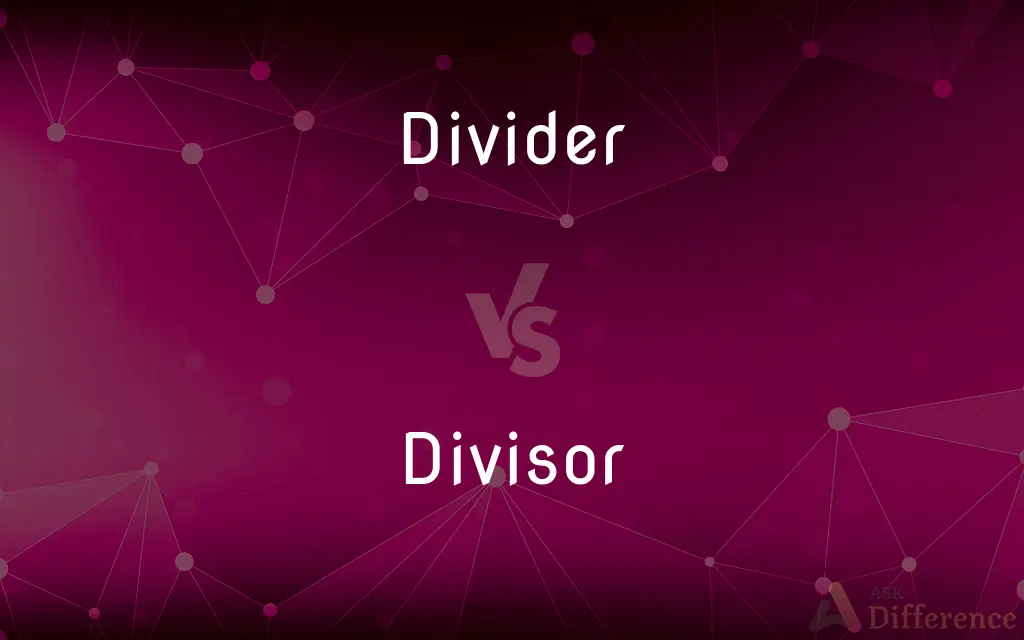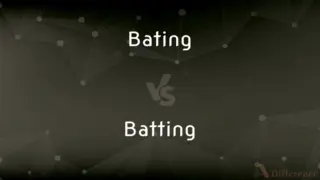Divider vs. Divisor — What's the Difference?
By Fiza Rafique & Maham Liaqat — Updated on March 21, 2024
A divider is a tool used in drafting for measuring distances or transferring measurements, while a divisor is a number by which another number is divided in mathematics.

Difference Between Divider and Divisor
Table of Contents
ADVERTISEMENT
Key Differences
In the context of tools and drafting, a divider is a compass-like instrument with two arms used to measure or transfer distances on a map or blueprint. On the other hand, in mathematics, a divisor is a number that divides another number, possibly leaving a remainder. This distinction highlights the difference in application fields: one is a physical tool in engineering and drafting, while the other is a conceptual tool in mathematics.
The functionality also differs significantly. A divider is physically manipulated to compare distances or mark out specific lengths, often in the creation of technical drawings or when working with physical maps. A divisor, however, is part of an arithmetic operation, used to determine how many times it fits into another number, the dividend, in division.
The precision and usage context of these terms are crucial. In drafting, the precision of a divider's points and the steadiness of the user's hand determine the accuracy of the measurement or transferred distance. In mathematics, precision involves the accuracy of numerical calculations and the understanding of division as an arithmetic operation.
Moreover, the skillset required to use a divider versus understanding divisors is distinct. Effective use of a divider requires physical dexterity and spatial understanding, whereas working with divisors demands numerical literacy and mathematical reasoning.
Comparison Chart
Definition
A tool used in drafting to measure or transfer distances.
A number by which another number is divided in mathematics.
ADVERTISEMENT
Application Field
Engineering, drafting, and map-making.
Mathematics, specifically in arithmetic operations.
Functionality
Used to physically measure distances or transfer measurements.
Used in division to determine how many times it divides into another number.
Precision
Depends on the physical accuracy and steadiness of use.
Relies on numerical accuracy and the correct application of division.
Required Skillset
Physical dexterity and spatial understanding.
Numerical literacy and mathematical reasoning.
Compare with Definitions
Divider
A drafting instrument consisting of two pointed arms hinged together, used to measure distances.
The architect used a divider to accurately transfer the measurements from the plan to the model.
Divisor
A number by which another number is divided in a division operation.
In the equation 15 ÷ 3 = 5, 3 is the divisor.
Divider
A tool in geometry for comparing lengths or drawing circles and arcs.
With a divider, the student drew a perfect circle by keeping one point stationary and rotating the other.
Divisor
In number theory, a divisor is an integral part of divisibility concepts.
A perfect number is equal to the sum of its proper divisors, excluding itself.
Divider
Used in navigation and map reading to measure distances between two points.
Using a divider, the navigator plotted the ship's course by measuring the distance on the nautical chart.
Divisor
In mathematics, a factor of a given number.
For the number 12, the divisors include 1, 2, 3, 4, 6, and 12.
Divider
In the physical world, a divider can also refer to a partition or barrier between spaces.
We installed a room divider to create a separate workspace in the large room.
Divisor
Used to express division in algebraic expressions.
In the expression x÷d=q, d represents the divisor.
Divider
An instrument for transferring measurements from one scale to another.
The carpenter used a divider to transfer the dimensions from the blueprint to the workpiece.
Divisor
In computational algorithms, divisors play a crucial role in operations and efficiency.
Optimizing divisors in an algorithm can significantly reduce computational time in factorization processes.
Divider
One that divides, especially a screen or other partition.
Divisor
In mathematics, a divisor of an integer n {\displaystyle n} , also called a factor of n {\displaystyle n} , is an integer m {\displaystyle m} that may be multiplied by some integer to produce n {\displaystyle n} . In this case, one also says that n {\displaystyle n} is a multiple of m .
Divider
Chiefly British A highway median strip.
Divisor
The quantity by which another quantity, the dividend, is to be divided.
Divider
A device resembling a compass, used for dividing lines and transferring measurements.
Divisor
(arithmetic) A number or expression that another is to be divided by.
In "42 ÷ 3" the divisor is the 3.
Divider
One who or that which divides or separates.
Divisor
An integer that divides another integer an integral number of times.
The positive divisors of 6 are 1, 2, 3 and 6.
Divider
A physical object for dividing up a space.
Divisor
The number by which the dividend is divided.
Divider
A piece of card placed in a ring binder to separate groups of documents.
Divisor
One of two or more integers that can be exactly divided into another integer;
What are the 4 factors of 6?
Divider
An electronic device for separating a signal, frequency, etc., into two or more parts.
Divisor
The number by which a dividend is divided
Divider
A device resembling a drawing compass and used to transfer measurements of length.
Divider
The median (US) or central reservation (UK) of a highway or other road where traffic in opposite directions are kept separated.
Divider
One who, or that which, divides; that which separates anything into parts.
Divider
One who deals out to each his share.
Who made me a judge or a divider over you?
Divider
One who, or that which, causes division.
Hate is of all things the mightiest divider.
Money, the great divider of the world.
Divider
An instrument for dividing lines, describing circles, etc., compasses. See Compasses.
Divider
A vertical structure that divides or separates (as a wall divides one room from another).
Divider
A taxonomist who classifies organisms into many groups on the basis of relatively minor characteristics
Divider
A person who separates something into parts or groups
Divider
A vertical structure that divides or separates (as a wall divides one room from another)
Common Curiosities
How does the precision of using a divider compare to calculating with a divisor?
Precision with a divider depends on physical accuracy, while with a divisor, it's about numerical calculation accuracy.
Can a divider be used in mathematics?
While primarily a drafting tool, a divider can be used in geometry for drawing or comparing lengths.
Is a divisor always a whole number?
In most contexts, a divisor is a whole number, but in advanced mathematics, divisors can be any real or complex number.
Can a divisor be negative?
Yes, a divisor can be negative, affecting the sign of the quotient in division.
What role does a divisor play in divisibility rules?
Divisors are central to understanding which numbers divide others without leaving a remainder, foundational in divisibility rules.
What's the significance of a zero divisor?
In mathematics, division by zero is undefined, making a zero divisor a critical concept to avoid in calculations.
How do dividers assist in map reading?
Dividers help measure distances on maps, crucial for navigation and planning.
What distinguishes a divider from a divisor?
A divider is a physical drafting tool for measuring distances, while a divisor is a numerical concept used in division.
What is the importance of divisors in number theory?
Divisors are fundamental in studying numbers' properties, relationships, and patterns in number theory.
How do divisors contribute to mathematical problem-solving?
Understanding divisors is crucial in solving problems involving division, factors, and multiples.
Can dividers and divisors be interchangeable in any context?
No, their specific applications in drafting and mathematics make them non-interchangeable.
Are divisors used outside of arithmetic?
Yes, divisors are used in algebra, number theory, and various fields of mathematics.
How is a divisor related to factors?
A divisor is essentially a factor of a number, representing numbers that divide it without a remainder.
What advancements have been made in the use of dividers?
Technological advancements have led to more precise and versatile divider designs, enhancing their utility in various applications.
Can the function of a divider be replicated digitally?
Digital tools can simulate a divider's function, especially in CAD software, offering precision and ease.
Share Your Discovery

Previous Comparison
Bating vs. Batting
Next Comparison
Danger vs. PerilAuthor Spotlight
Written by
Fiza RafiqueFiza Rafique is a skilled content writer at AskDifference.com, where she meticulously refines and enhances written pieces. Drawing from her vast editorial expertise, Fiza ensures clarity, accuracy, and precision in every article. Passionate about language, she continually seeks to elevate the quality of content for readers worldwide.
Co-written by
Maham Liaqat












































